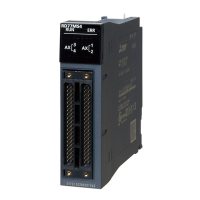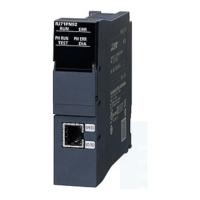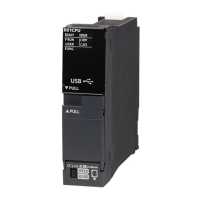
Do you have a question about the Mitsubishi Electric RV-8CRL and is the answer not in the manual?
| Control Axes | 8 axes |
|---|---|
| Protection Class | IP20 |
| Number of Axes | 8 |
| Interface | Ethernet, RS-232 |
| Programming Method | MELFA BASIC V |
| Operating Environment Temperature | 0–40°C |
| Storage Temperature | -20 to 70°C |
Requirement for trained operators and preparation for work.
Necessity of a work plan for teaching and maintenance.
Importance of having an immediately stoppable device.
Visual indication for ongoing teaching work.
Requirement for a fence to prevent contact.
Establishing a signaling method for starting work.
Visual indication for ongoing maintenance work.
Pre-work inspection of robot and safety devices.
Using the robot within specified environmental conditions.
Safe transportation and secure table installation.
Proper wiring away from noise sources and cable handling.
Ensuring workpiece weight and tool installation are secure.
Importance of grounding and indicating robot operation status.
Securing control priority during teaching work.
Safety measures for jog operation and program verification.
Ensuring automatic stop when safety fence door is opened.
Avoiding modifications and using only specified parts.
Precautions when moving robot arm manually to avoid finger injury.
Safety regarding power interruption and its effect on accuracy/damage.
Safety considerations when using GOT direct connection function.
Safety precautions for handling SSCNET III cables and connectors.
Attaching caps to SSCNET III connectors to prevent contamination.
Ensuring correct wiring and checking all functions after setup.
Using manufacturer-confirmed network equipment and considering the FA environment.
Taking measures against unauthorized access via network and internet.
Installing an earth leakage breaker for primary side power supply protection.
List of items required for primary power supply connection.
Step-by-step guide for connecting the ACIN cable to the controller.
Overview of compact vertical multi-joint robots and their applications.
Explanation of how specifications are organized across different sections.
Details on standard and special structural equipment components.
Information on user-installable options.
Materials and parts for maintenance use.
Explains how to identify the robot model based on its naming convention.
Table showing compatible robot arm and controller types.
Details and illustration of the robot arm as structural equipment.
Overview of devices that can be installed on the controller.
List of available options for the controller.
Description of optional devices to extend robot functionality.
Table listing optional equipment and special specifications for the robot arm.
Table listing optional equipment and special specifications for the controller.
Table detailing function extension devices like force sensors and vision systems.
Recommendations for USB cables, including caution notes on static and noise.
Table listing key specifications like environment, degrees of freedom, motors, ranges, speeds, loads, and protection.
Details on forces applied to the installation surface for strength design.
Definition and conditions affecting pose repeatability accuracy.
Details on mass capacity, inertia, moment, and operational influences.
Parameter settings for hand and work load capacity and size.
Causes and measures to reduce vibrations during low-speed operation.
Details on the collision detection function, its parameters, and sensitivity adjustment.
Table outlining IP ratings and their applicable fields for the robot arm.
Guidance on using the robot in environments with oil mist or water.
Diagram labeling the main parts of the robot arm.
Drawings showing external dimensions and installation details of the robot arm.
Illustration showing the robot's operating range and axis limits.
Dimensions of machine cables, referencing replaceable types.
Configuration for wiring and piping to a standard-equipped hand.
Information on internal wiring, pneumatic hoses, and hand cable specifications.
Example air supply circuit for the hand.
Guidelines for installing tooling wiring/piping.
Diagram showing screw hole locations for fixing wiring and piping.
Introduction to robot options and the requirement for customer installation.
Details on the fixed type replaceable machine cable for extending reach.
Details on the flexed type replaceable machine cable and its specifications.
Cable configuration for flexed type.
Method for fixing the flexible cable.
Explanation of robot overhaul, recommended intervals, and maintenance.
List of consumable parts for the robot arm and how to purchase them.
Table listing controller type, memory, language, I/O, interfaces, power, and construction.
Additional controller specs: ambient conditions, grounding, power consumption.
Details on controller protection (IP20) against solids and fluids.
Operating supply requirements and safety device specifications.
Diagram labeling connectors and terminals on the rear of the controller.
Identification of LEDs, fuses, connectors, and slots on the controller.
Drawings showing the external dimensions of the controller.
Guidelines and figures for controller installation in horizontal and vertical orientations.
Reference figure for the dimensions of a metal plate for vertical controller mounting.
Overview of controller external I/O types and their functions.
Table detailing dedicated input/output signals and their functions for robot control.
Further details on dedicated I/O signals for program selection, jog, and hand control.
Details on pneumatic error signals and maintenance time warning signals.
Information on wiring external emergency stop, door switch, and mode selector switches.
Cautions regarding wiring for emergency stop, door switch, and mode selector functions.
Circuit diagrams illustrating external emergency stop and related connections.
Step-by-step guide for wiring to user connectors and precautions.
Electrical specifications and connection for the special stop input (SKIP).
Explanation of door switch function and its effect on robot operation.
Explanation of mode selector switch operation.
Table detailing switch settings for Jog, Brake Release, and Automatic Operation.
Information on the additional axis interface and dedicated connectors.
Recommended filters for EMC compliance and servo amplifier combinations.
Examples of EMC noise filter installation and types.
Circuit examples for synchronizing additional axis servo status with the robot arm.
Image showing the AXMC terminal connector for additional axis synchronization.
Introduction to controller options and the requirement for customer installation.
Details on the standard teaching pendant (R32TB) including functions and specifications.
Drawings showing the outside dimensions of the teaching pendant.
Explanation of the teaching pendant's keys and their main functions.
Details on the high efficiency teaching pendant (R56TB) and its specifications.
Detailed explanation of the teaching pendant's keys and their operations.
Details on the controller protection box (CR800-MB) for dust and water protection.
Drawings showing the outside dimensions of the controller protection box.
Diagram labeling the parts of the controller protection box.
Wiring diagram for the controller protection box and its connections.
Guidelines for installing the controller protection box.
Overview of MELSOFT RT ToolBox3 software for robot operation and programming.
Table detailing functions available in MELSOFT RT ToolBox3, RT ToolBox3 mini, and RT ToolBox3 Pro.
Overview of the contents and purposes of the accompanying instruction manuals.
Details on the parallel I/O interface (sink/source types) and its electrical specifications.
Electrical specifications for the output circuits of the parallel I/O interface.
Pin arrangement and signal assignment for the parallel I/O unit based on station number.
Details of signal assignments for the CN100 connector, including wire colors.
Example connections for sink and source type PLCs to the robot controller.
Specifications and pin/cable color details for the external I/O cable.
Details on external I/O cable connections and outside dimensions.
Configuration and specifications for the parallel I/O unit, including connection requirements.
Electrical specifications for input and output circuits of the parallel I/O unit.
Specifications for various connection cables and lists of parts with manufacturers.
Guidelines for installing the parallel I/O unit outside the controller.
Instructions for connecting the parallel I/O unit via network and DC cables.
Table detailing pin assignment and signal mapping for the parallel I/O unit based on station number.
Details of signal assignments for the CN100 connector, including wire colors.
Details of signal assignments for the CN300 connector, including wire colors.
Example connections for sink and source type PLCs to the robot controller.
Specifications and pin/cable color details for the external I/O cable.
Details on external I/O cable connections and outside dimensions.
Details on the CC-Link interface, its configuration, and required customer-procured parts.
Detailed specifications for CC-Link communication, stations, and data transfer.
Overview of CC-Link interface functions, setup, and high-speed response.
Information on the SD memory card for extended memory and logging data.
List of consumable parts for the controller and how to purchase them.
Commands for structured programming, function procedures, and library functions.
Commands for controlling robot position, speed, and operation.
Commands for pallet definition, branching, and interrupt handling.
Commands for managing input/output and parallel execution.
Commands for defining variables, file operations, and comments.
Parameters for tool data, coordinate systems, and operation ranges.
Parameters for defining overrun limits for free plane movement.
Parameters for origin, program selection, communication settings, and slot tables.
Parameters for multi-tasking and display language settings.
Overview of the contents and purposes of the accompanying instruction manuals.
Table listing functions that trigger automatic robot stops based on system diagnostics.
Table describing stop functions triggered by teaching pendant or external input.
Table categorizing external signals for safety functions like emergency stop and door switch.
Guidelines for robot installation, workspace, and controller placement.
Measures to prevent operator contact, like safety fences and interlocks.
Safety in work procedures, training, and using signals.
Example wiring for emergency stop, door switch, and mode selector for safety.
Second example wiring for emergency stop and door switch with monitoring.
Third example wiring for dual controller setup with peripheral power supply.
Fourth example wiring connecting the controller to an external safety relay.
Detailed explanations and cautions for external emergency stop connections and wiring.
Guidelines for power supply voltage and capacity to ensure operation.
Avoiding noise sources and ensuring proper temperature/humidity.
Precautions against vibration, impact, and environmental conditions.
Important precautions for handling the robot arm and components.
Precautions during operation, power supply, and collision avoidance.
Precautions for transporting lithium batteries and handling fumigated materials.
Explanation of the European EMC directive regarding emission and immunity.
Common items and methods for implementing EMC measures.
Details on ferrite cores for common-mode noise reduction.
Details on line noise filters for AC input lines.
Example calculation for load moment on the J5 axis.
Example calculation for load inertia on the J6 axis.
Classification of external input/output signals based on their functions and safety relevance.
Explanation of the safety diagnosis function using test pulses for emergency stop lines.
Block diagram illustrating the safety control system architecture.
Customer information and a checklist for robot selection and options.











